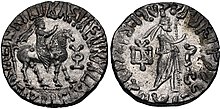Abdagases I (Greek: Ἀβδαγάσης, epigraphically ΑΒΔΑΓΑΣΟΥ; Kharosthi: 𐨀𐨬𐨡𐨒𐨮 A-va-da-ga-ṣa, Avadagaṣa[1][2]) was an Indo-Parthian king, who ruled Gandhara and possibly over most of the Indus region from c. 46 to 60 AD. He was a nephew and successor of Gondophares, who had laid foundations for the Indo-Parthian kingdom after revolting against his Arsacid overlords in c. 19 AD.[3] Abdagases was succeeded by Orthaghnes or Pacores.[1]
| Abdagases I | |
|---|---|
 | |
| Indo-Parthian king | |
| Reign | c. 46 – c. 60 |
| Predecessor | Gondophares |
| Successor | Orthagnes or Pacores |
| Died | 60 |
| House | House of Suren |
| Religion | Mithraism (?)[a] |
Life
Abdagases belonged to the House of Suren, [citation needed] a prominent and influential family within the Arsacid Empire. He succeeded his uncle Gondophares as the ruler of Gandhara in c. 46 AD, whilst Orthagnes succeeded him at Drangiana and Arachosia.[4] The figure of Abdagases is obscure; according to Gazerani, it is likely that Abdagases may have been the same person as another Abdagases,[5] an influential and powerful Suren noble in the Arsacid Empire, who belonged to a faction of Parthian magnates that were dissatisfied with the Parthian king Artabanus II. The Parthian magnates had at first favoured a grandson of Phraates IV, also named Phraates as a better choice for king. However, he met an abrupt death in Syria.[3] The Parthian magnates then turned to another prince, Tiridates III, who was crowned by Abdagases.[6]
Some of the Parthian magnates, however, were supporters of Artabanus II, due to their concern that Abdagases would become the de facto ruler of the Arsacid Empire, with Tiridates as a figurehead.[6] As a result, Abdagases and his son Sinnacus withdrew their support from Tiridates as well.[6] This event seems to have coincided with the declaration of independence in Sakastan by the Suren family under Gondophares.[6] The identification of the two Abdagases figures, although supported by some scholars, nevertheless still remains indecisive, due to the lack of numismatic evidence.[6] Abdagases ruled as king till c. 60 AD, and was succeeded by Orthagnes or Pacores.[1]
Notes
a: The faith of the House of Suren remains uninvestigated in current scholarship. Pourshariati has suggested a faith based on the worship of Mithra being practiced by some of the Parthian families.[7]
References
Sources
- Gazerani, Saghi (2015). The Sistani Cycle of Epics and Iran's National History: On the Margins of Historiography. BRILL. pp. 1–250. ISBN 9789004282964.
- Rezakhani, Khodadad (2017). ReOrienting the Sasanians: East Iran in Late Antiquity. Edinburgh University Press. pp. 1–256. ISBN 9781474400305.
- Brunner, C. J. (1982). "Abdagases". Encyclopaedia Iranica, Vol. I, Fasc. 2. p. 172.